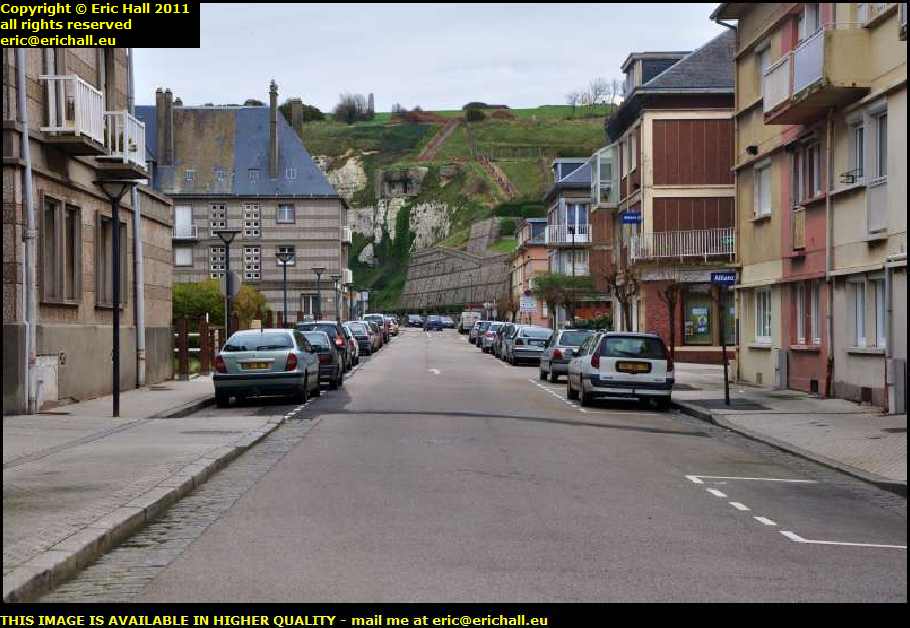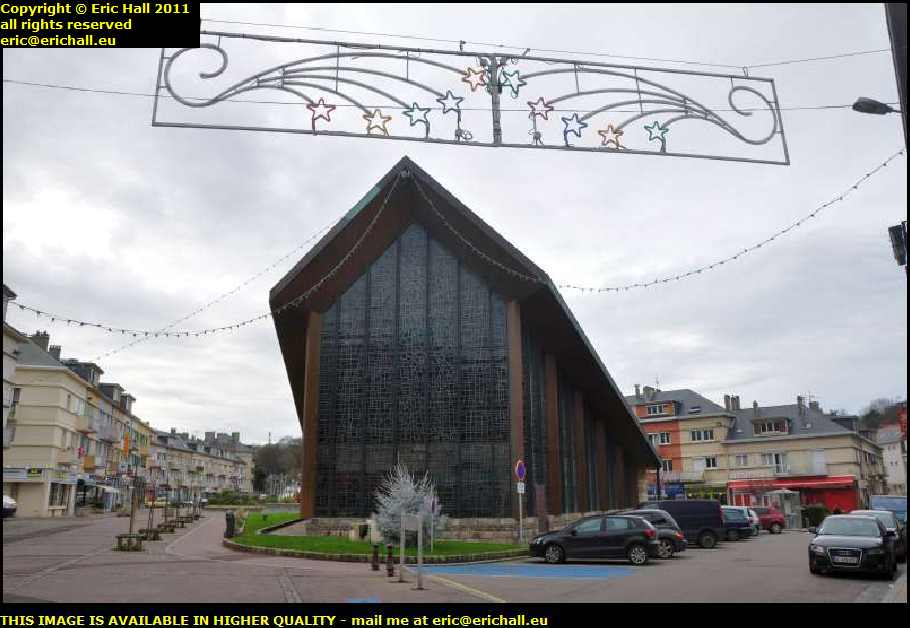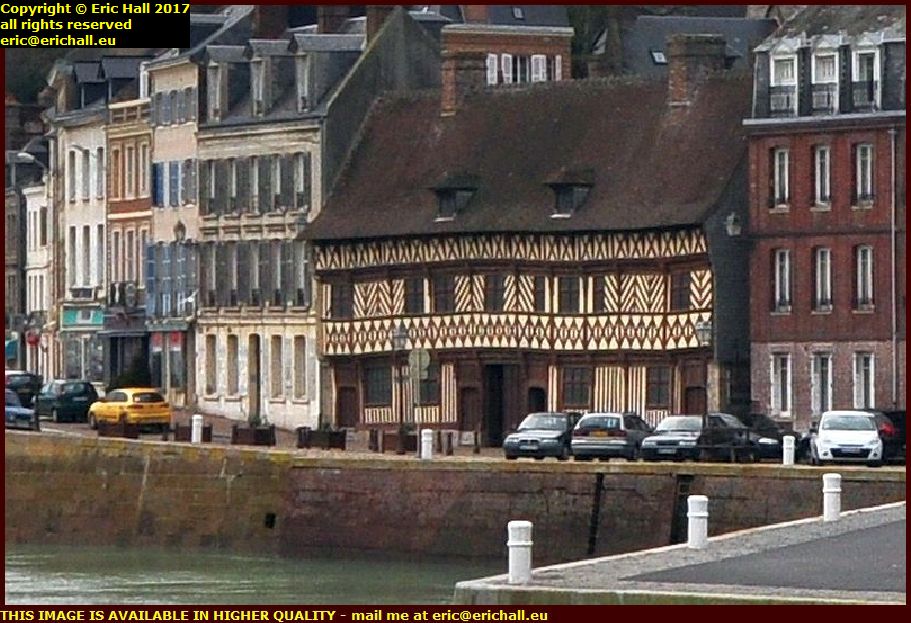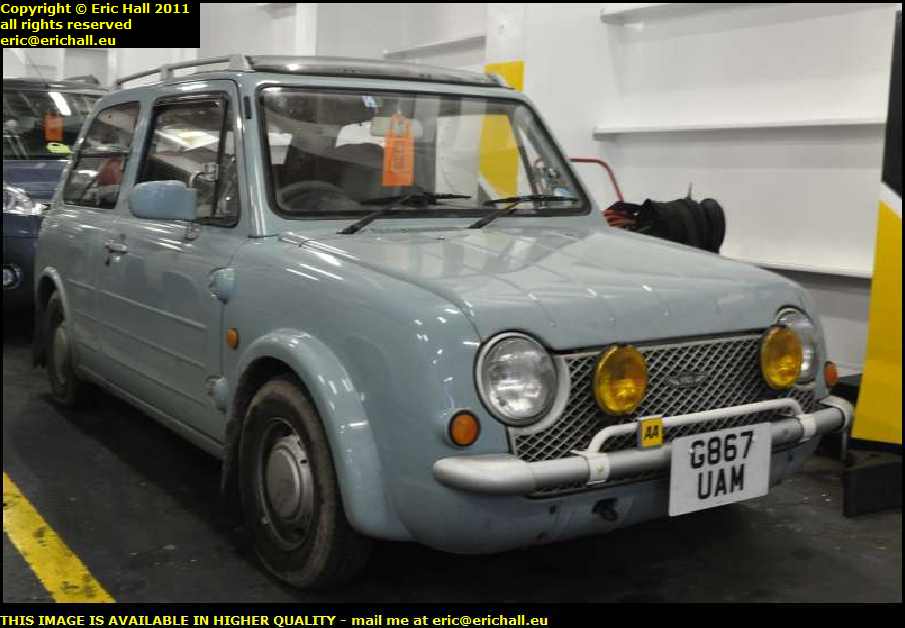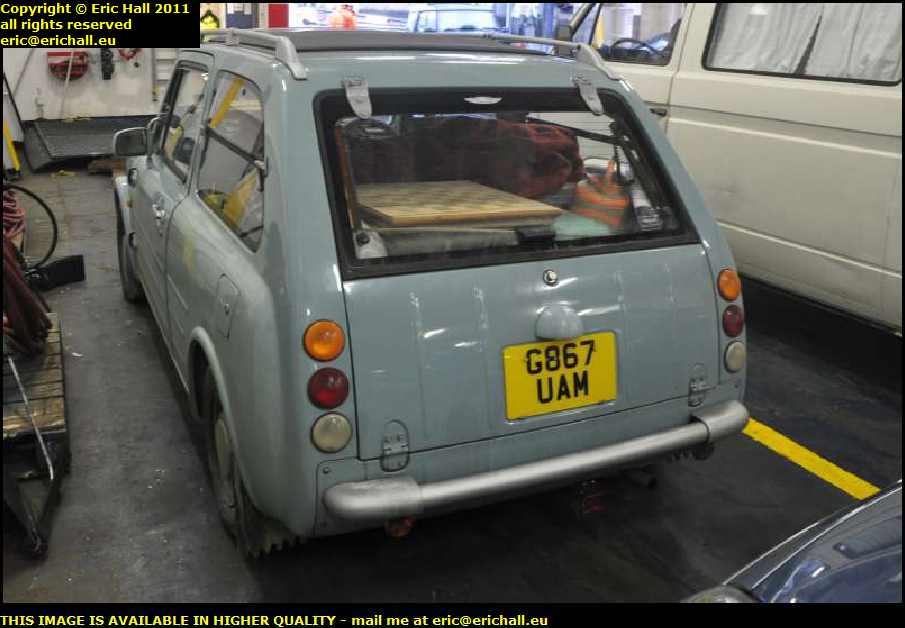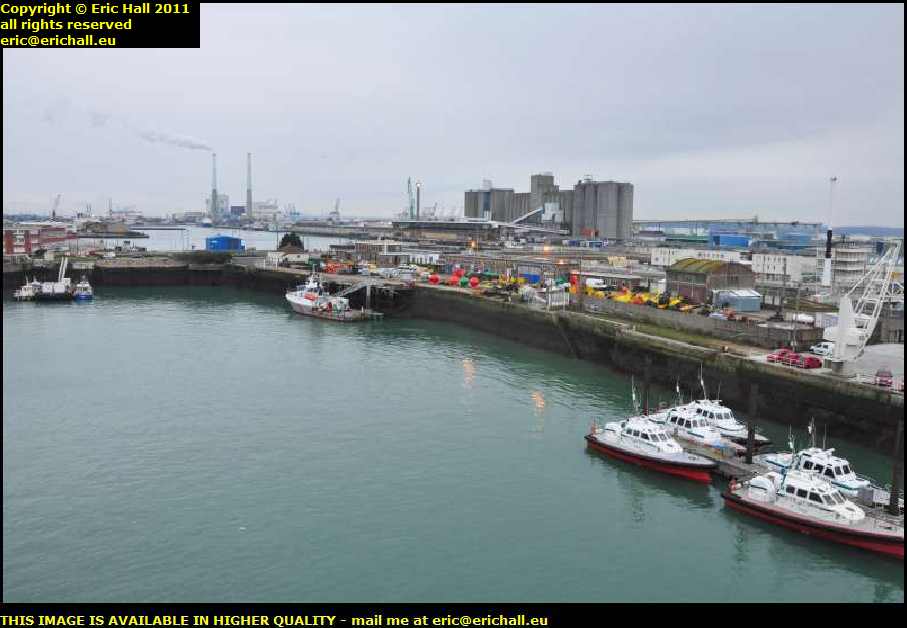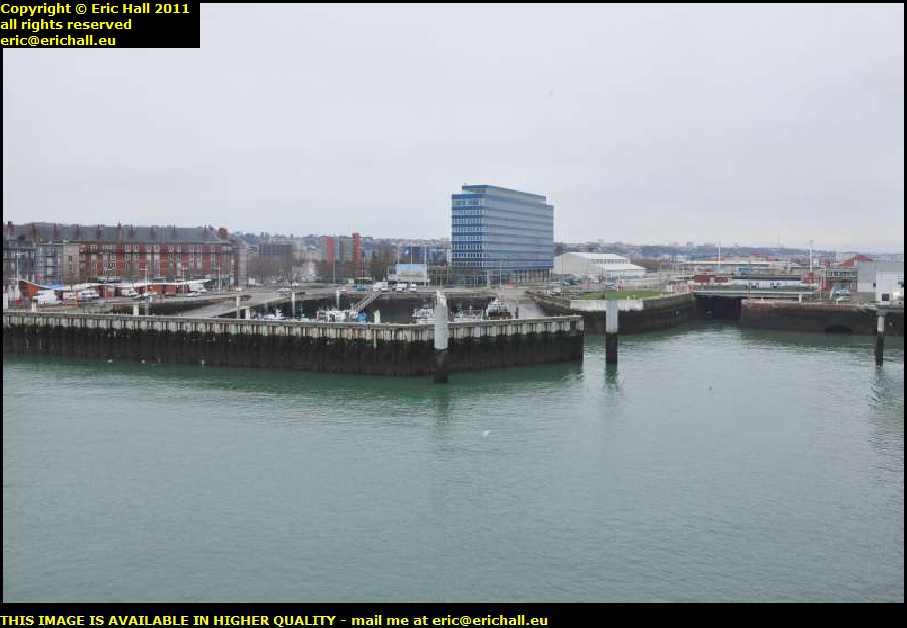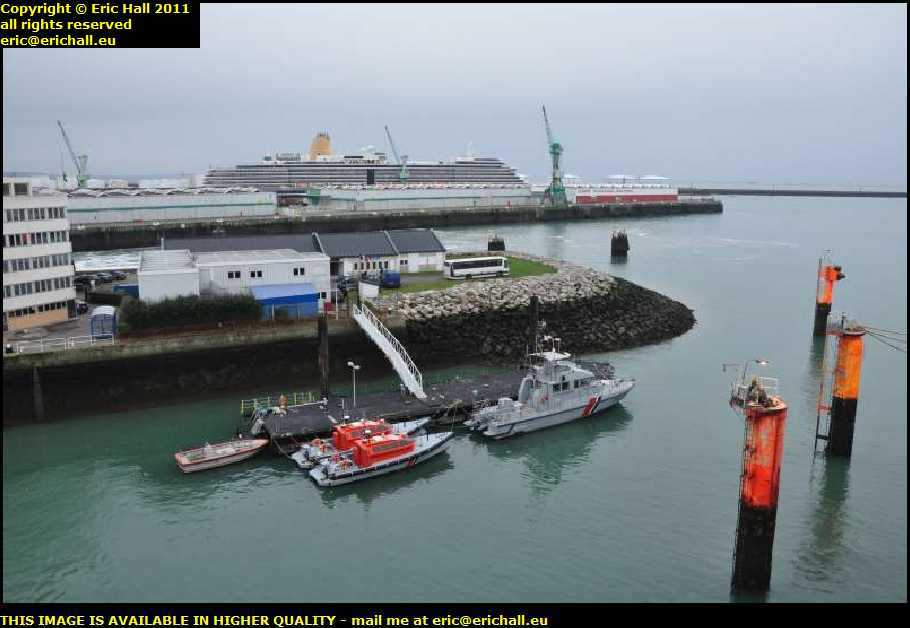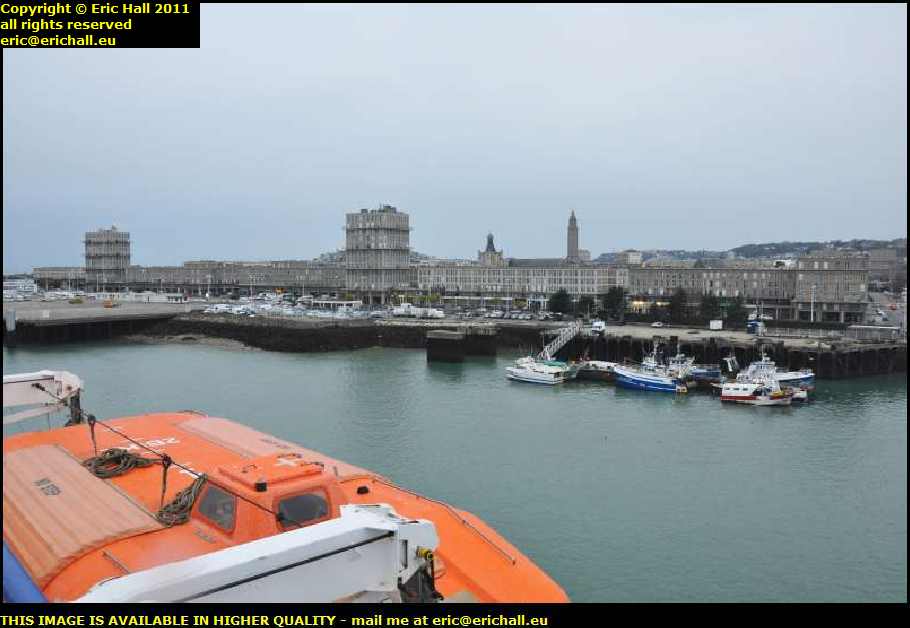… done in for the next few days, I reckon. I’ve really had a busy day today and I was in something of a little agony when I finally crawled myself off to bed.I couldn’t even stay awake long enough to watch a 25-minute film either!
Mind you, there’s a very good reason (or two) for this – not the least of which was that I was wide awake at some kind of silly time like 04:00 and didn’t have any idea about going back to sleep again.
However, I must have done, because I was wide awake yet again at about 06:30. And this time I managed to stay awake too, having breakfast when the alarms went off (and it’s not the first time just recently that this has happened either).
After a little bit of dillying and dallying this morning I went outside to wait for Alison who came to pick me up. She took me back to her house to see around the garden, and I took the opportunity to say “hello” to Brian, whom I hadn’t seen for a while.
Jennifer then climbed into the car with us and then we hit the highway, direction Ieper (or, for those of you with very long memories, Ypres). Neither Jenny nor Alison had been there before and it was on their list of places to visit, and so I had offered to accompany them. Regular readers of this rubbish will recall that back in the dim and distant past that for the University course that I was studying at the time, I wrote a thesis comparing the rebuilding of Ieper with the rebuilding of Coventry.
Good Friday isn’t a Bank Holiday in Belgium, and so we had the usual chaotic drive around the Brussels ring road in the usual kind of traffic that makes driving the M25 look like a stroll down a country lane, but nevertheless we made it eventually to Ieper.
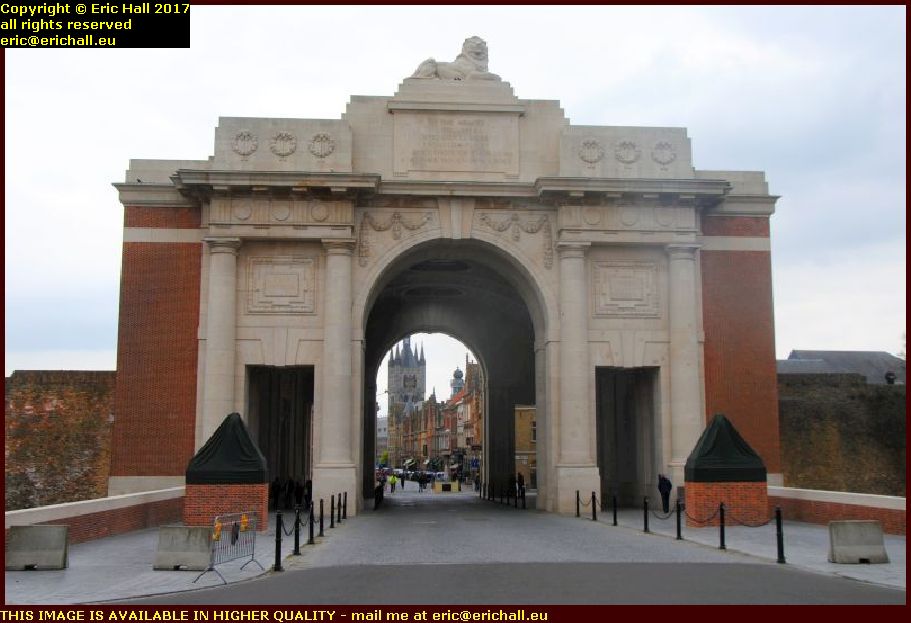 As luck would have it, there was a parking space right by the side of the city walls near the Menin Gate and so Alison’s impressive driving soon had us neatly parked.
As luck would have it, there was a parking space right by the side of the city walls near the Menin Gate and so Alison’s impressive driving soon had us neatly parked.
Three hours free parking outside the city walls, which is a good deal on any kind of basis and that gave us plenty of time to do a little sightseeing around the city before clearing off into the surrounding countryside.
 The Gate itself is fascinating. The original one had been demolished as it was considered to be a restriction to modern traffic, but a new one was built here after the war by the British as a memorial to the missing.
The Gate itself is fascinating. The original one had been demolished as it was considered to be a restriction to modern traffic, but a new one was built here after the war by the British as a memorial to the missing.
Of the quarter of a million or so British soldiers who died in the Battles around Ieper, probably half of them were never recovered or identified, and the idea was to write their names up on panels on the gate.
However, despite several expansions, the Gate was never ever large enough, and they abandoned the plan half-way through. Instead, they continued the work by installing panels on a wall at the cemetery.
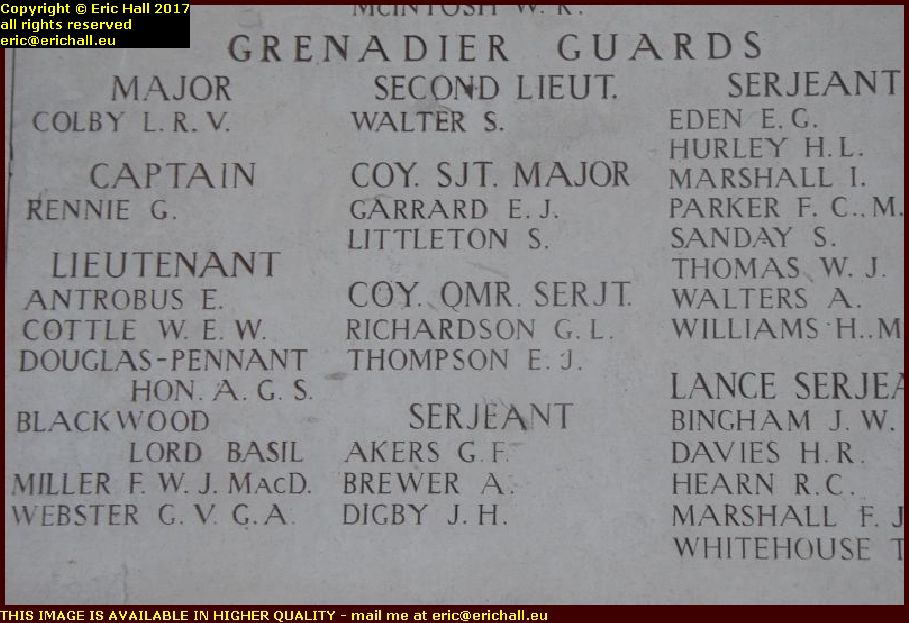 It’s interesting to look at the panels and see if there’s anyone there whom you can identify. One name leaps to mind out of that lot on there and that is Lord Basil Blackwood.
It’s interesting to look at the panels and see if there’s anyone there whom you can identify. One name leaps to mind out of that lot on there and that is Lord Basil Blackwood.
A big friend of Maurice Baring and featuring heavily in Baring’s semi-autobiographical Flying Corps Headquarters, he was a well-known illustrator of children’s books as well as being a competent barrister.
Ironically, he actually featured in one of my nocturnal rambles a year or so ago.
Another name on there is that of the Honourable Alan George Sholto Douglas-Pennant. His claim to fame is that he was the heir apparent to the title of the Earl of Penrhyn.
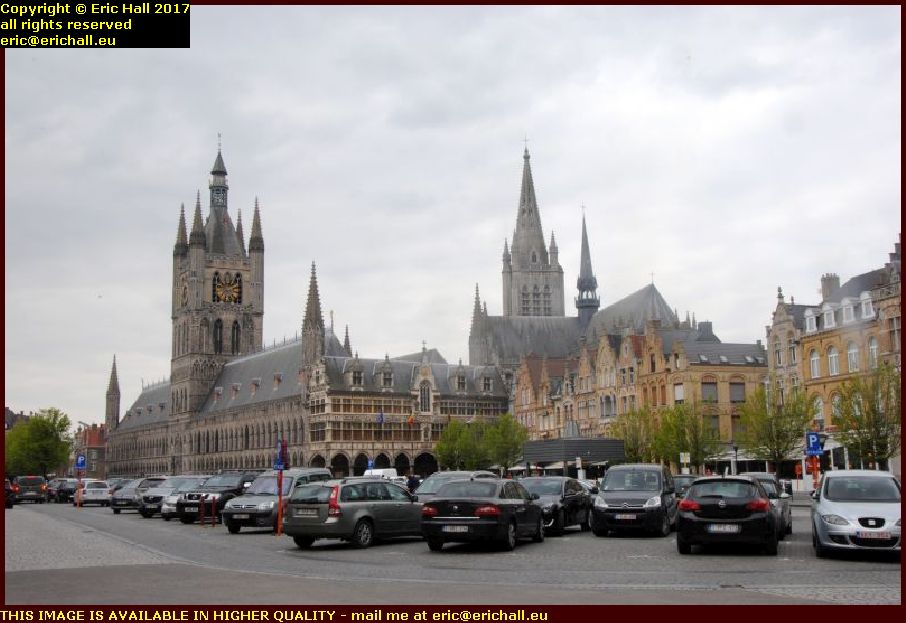 We headed off into the city centre to look at the Cloth hall and the Cathedral.
We headed off into the city centre to look at the Cloth hall and the Cathedral.
You can immediately see just how rich Ieper had been as a town simply by looking at the buildings here. The 15th and 16th Century was a time of great prosperity for the city, its fortunes being based on the woollen trade. However, by the time of the First World War, its fame and fortune had long-since passed it by.
if you had come here in 1919, all that you would have seen of the city would have been assorted piles of rubble. During the period from October 1914 until late 1917, the city was being systematically flattened by German artillery until nothing remained.
Many years ago I read the diary of the priest (or whatever ecclesiastic title he would have held) of the Cathedral in which he described day-by-day the destruction and devastation that was happening in his parish and the agonising deaths that many of his parishioners suffered.
But by chance, the original plans of the city were rediscovered after the war and this enabled much of the city, including the Cloth Hall and the Cathedral, to be rebuilt more-or-less exactly how it used to be, and it’s a testament to the skill and labour of the craftsmen that they managed it so successfully when compared to the absolutely dreadful attempts by the UK and the Donald Gibson School of Wanton Vandalism to “modernise” its cities after the Luftwaffe blitz
We found a little burger bar where not only did they have veggie burgers but gluten-free buns. We were all able to have a decent late-lunch/early-tea, and doesn’t that make a nice change?
Things are looking up!
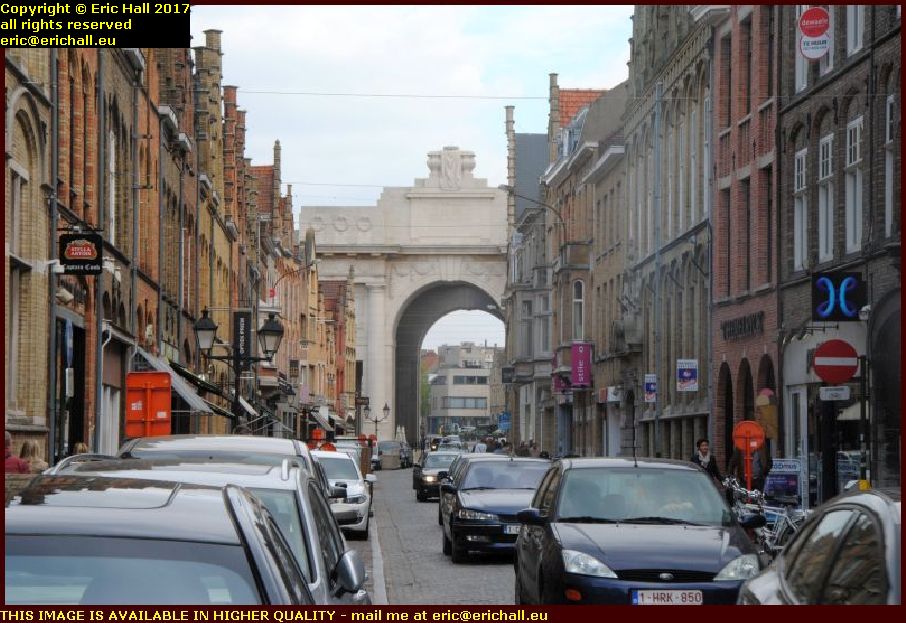 Jenny had some shopping to do so we wandered back up town towards the Menin gate and the car.
Jenny had some shopping to do so we wandered back up town towards the Menin gate and the car.
This gave us an opportunity to see the Gate from this viewpoint and to admire the facades of the houses that lined the street. It’s a magnificent rebuilding job that was carried out here after the First World War.
It’s just a shame that there is so much traffic in the street. But it IS Easter Holiday in the UK of course, and that’s why Jenny is here
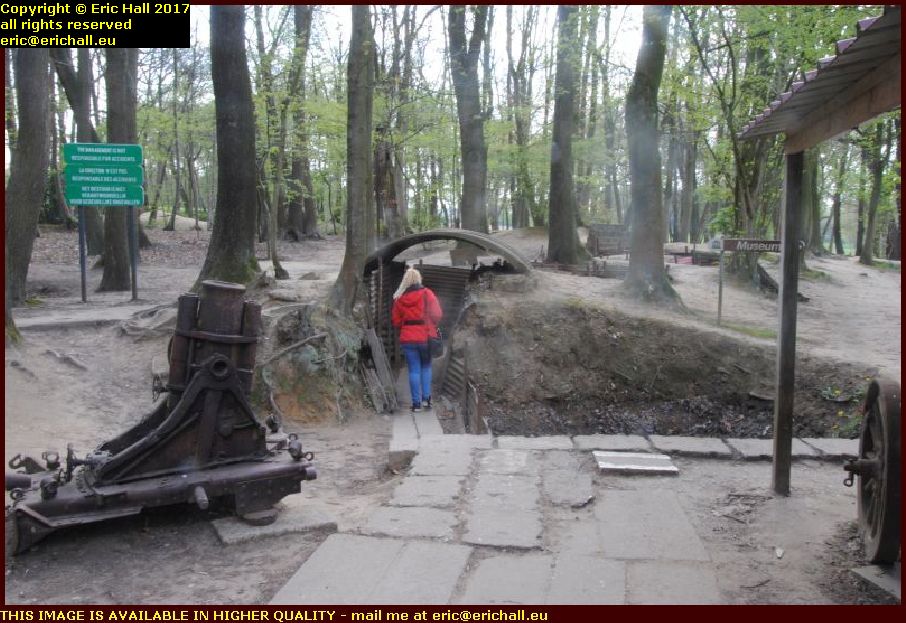 There’s a museum out on the edge of the city where artefacts dating from the battles here had been taken to be put on display, and this was one place that Alison and Jenny wanted to visit.
There’s a museum out on the edge of the city where artefacts dating from the battles here had been taken to be put on display, and this was one place that Alison and Jenny wanted to visit.
Here’s Jenny just disappearing into a trench that was being protected by an old trench mortar of the type that the British used to lob projectiles from their trenches into the German trenches which, sometimes, were no more than 20 metres away across No-Man’s Land (or No Person’s Land as I really have heard it described).
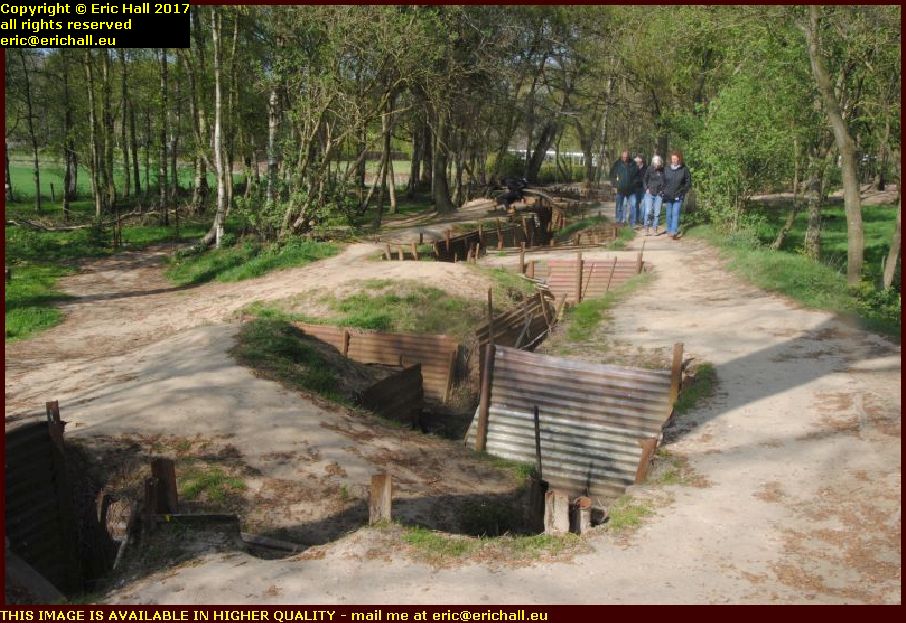 The people here had bought a section of what was, I believe, the British second-line trenches during the battles here, and had kept them in some kind of state of how they might have been during the fighting.
The people here had bought a section of what was, I believe, the British second-line trenches during the battles here, and had kept them in some kind of state of how they might have been during the fighting.
Of course, it’s very difficult for the trenches to remain intact after 100 years, but hats off to them for having a go. It’s the nearest that you will ever come to understanding the suffering that the soldiers of the various armies had to go through during the First World War
There were all kinds of relics recovered from the battlefield and stored here to give you an idea of the items that were being used on the battlefield.
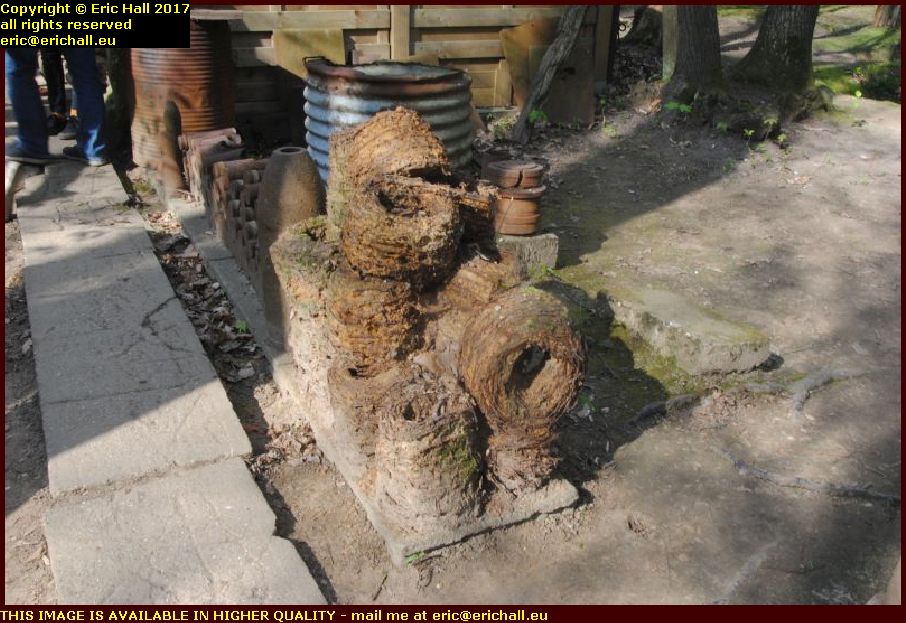 Barbed wire was probably one of the most common items to be used out here, and they had recovered several rolls of the stuff over the years. Horrible nasty stuff that can tear you to shreds and which was used to impede movement in No-Mans Land.
Barbed wire was probably one of the most common items to be used out here, and they had recovered several rolls of the stuff over the years. Horrible nasty stuff that can tear you to shreds and which was used to impede movement in No-Mans Land.
The Germans had a very nasty habit of whenever there was about to be a British attack, they would sneak out and carefully cut the wire in strategic places so as to channel the attacking British and French troops down predictable pathways, which were then covered by a couple of heavy machine guns.
Ludovic Kennedy reckoned that of the hundreds of thousands of Allied troops who were killed on the Somme and at the Third Battle of Ypres, most were killed by no more than a few hundred German machine-gunners.
 I wanted to come here again because when I had been here before they had brought in a radial engine from a World War 1 aeroplane that had crashed on the battlefield.
I wanted to come here again because when I had been here before they had brought in a radial engine from a World War 1 aeroplane that had crashed on the battlefield.
I was hoping that they might have cleaned it up but apparently that’s not within the remit of the museum, so I couldn’t even tell if it was German or Allied, never mind what make it might have been.
They were usually either 7 or 9-cylinder engines (sometimes in two banks) and this one is a 9-cylinder.
The principle of the radial engine is that the engine rotates around the pistons, not the other way around. They produce a lot of lateral torque as you might expect and so required a great deal of concentration to fly.
However the torque could be an advantage because if you were being chased across the sky by an enemy machine, relaxing your grip would let the torque take over and the machine would shoot off at random unpredictably all over the sky and the aeroplane chasing you couldn’t follow you.
The British however generally insisted on stable machines that would fly predictably and easily, and hence they were shot down like flies.
 Outside, we went up to Hill 62 to see if we could see the Hooge Crater – the hole that had been created by the massive mining, tunnelling and explosive works of the british to demolish the German defences.
Outside, we went up to Hill 62 to see if we could see the Hooge Crater – the hole that had been created by the massive mining, tunnelling and explosive works of the british to demolish the German defences.
It’s not clearly visible but the city of Ieper is, and you can see why it was imperative for the British to capture the hill from the Germans, for from here they could rain down shells and bullet on the city with impunity.
People often talk about the heavy losses that were sustained by capturing positions like these, but from the top of the hill it’s very easy to imagine the casualties that would have sustained from a battery of field guns had they been allowed to remain here unopposed.
 From here we went on through Zonnebeke on the road to Passendale – or Passchendaele – where we stopped at the Tyne Cot military cemetery half-way up the hill.
From here we went on through Zonnebeke on the road to Passendale – or Passchendaele – where we stopped at the Tyne Cot military cemetery half-way up the hill.
It’s by far and away the largest British military cemetery in the World and the even sadder thing about it is that more than half of the inmates are unidentified.
What is known about them is written on the tombstone – “an unidentified soldier of the First World War” means that they don’t even know his nationality. “A unidentified Second Lieutenant of the Black Watch” is more clear.
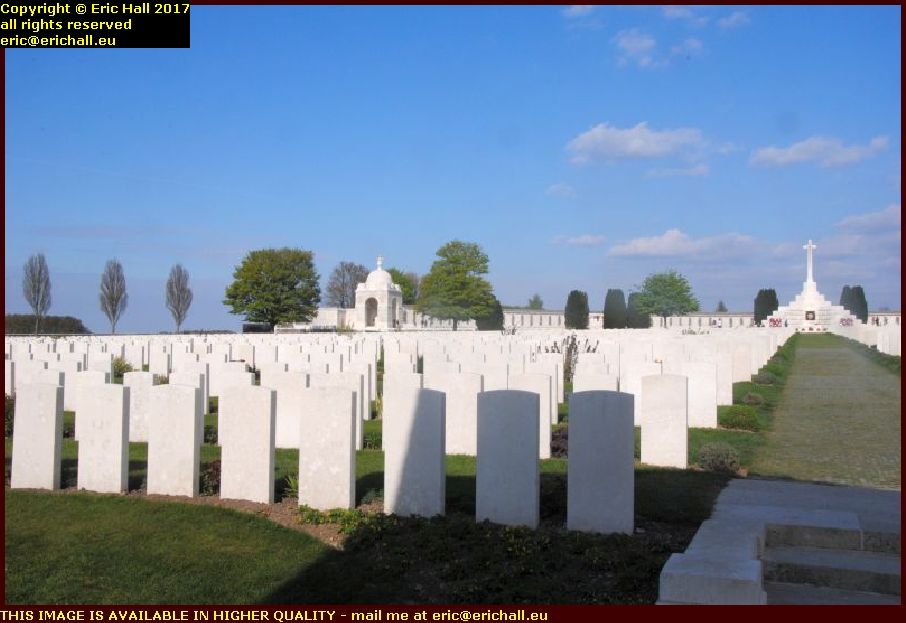 I mentioned earlier that at the Menin Gate they had eventually given up the idea of expanding it to include the names of all of the missing.
I mentioned earlier that at the Menin Gate they had eventually given up the idea of expanding it to include the names of all of the missing.
It’s here at Tyne Cot that they carried on, and all along the back wall are the names of tens of thousands more soldiers who disappeared into the morass that was the Third Battle of Ypres, or Passchendaele.
And to think that there are still some people (mainly Brits of course) who are still fighting this war
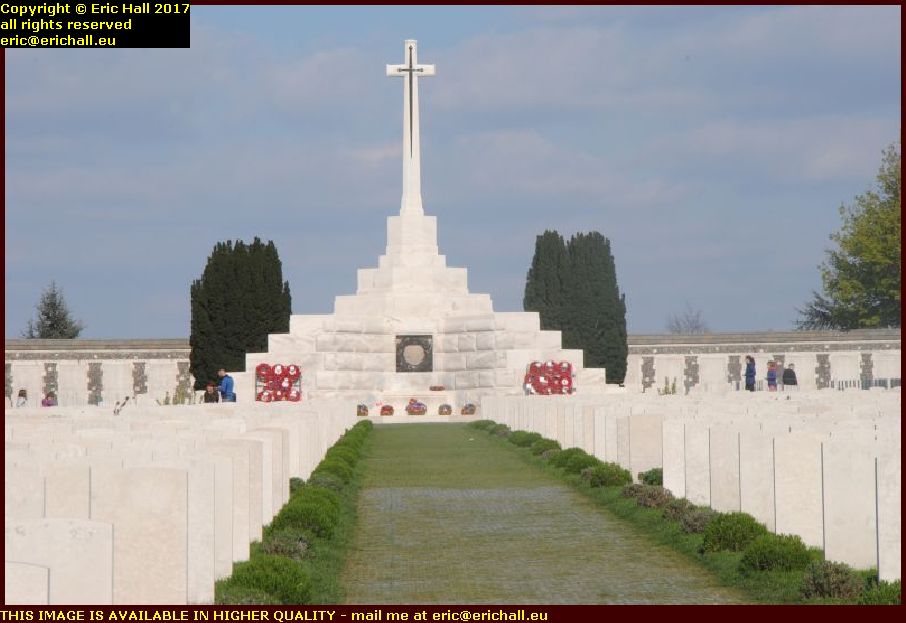 Douglas Haig came in for a lot of bitter criticism about his plan of attack – mainly from Captain Liddell-Hart and his acolytes in the 1950s and onwards.
Douglas Haig came in for a lot of bitter criticism about his plan of attack – mainly from Captain Liddell-Hart and his acolytes in the 1950s and onwards.
But Liddell-Hart’s vitriol, due mainly to his having been passed over for promotion on many occasions evenwhen officers were also dying like flies, obscures a couple of vital points that history has (conveniently for Liddell-Hart) totally forgotten.
- Haig wanted to attack in the late Spring and Summer after the Vimy Ridge offensive, when the weather would have been kinder. It was the British politicians who insisted that Haig postpone his attack, and overruled him at every step. And, just like Brexit politicians, they all ran away and hid when it all went wrong.
- Haig had a dreadful fear, and although subsequent events were to prove him wrong, contemporary knowledge was certainly on his side and he cannot be blamed for thinking the way he did.
After the dreadful carnage that was Verdun, the French Army was on the verge of mutiny and there was a strong call amongst left-wing politicians in France for an immediate end to hostilities.
If the French left-wingers had had their way, and France had withdrawn, what would have become of the British Army?
Being unable to fight in France, and being unable to resupply (as all of the ports used by the British Army were in France) the German Army would have simply waited until the British had run out of ammunition and then walked over and rounded them up.It was absolutely vital that the British reach the Belgian coast and capture a port at all costs if they were to continue the battle and not surrender to the Germans.
As it happened, the left-wingers in the French Government were defeated and order was restored, but Haig wasn’t to know this at the time of the battle. And history has very unkindly erased this chapter of the story from Modern Thought.
 Back in town again later, we went for a coffee and encountered another Belgian businessman who preferred to shut up his shop and go home instead of catering for the hundreds of people who were milling around the Menin Gate – no wonder that there’s a recession.
Back in town again later, we went for a coffee and encountered another Belgian businessman who preferred to shut up his shop and go home instead of catering for the hundreds of people who were milling around the Menin Gate – no wonder that there’s a recession.
At 20:00 every night the Belgian Fire Brigade have a parade here and blow the Last Post to commemorate the hundreds of thousands of British soldiers who died here to keep the city out of German hands (and as I have said before … "and on many occasions too" – ed … things must have gone dramatically wrong for the UK over the past 50 years if the Belgians prefer the Germans here these days).
The proceedings were interrupted by a British motorcyclist on a big Harley Davidson who rode the wrong way up a one-way street and revved his engine to drown out the ceremony (which explains a lot of what I have just said) but anyway, we headed back to the car afterwards for our journey back.
And now I’m exhausted. I’ve had a heavy day and it’s just as well that I’ve organised a Day of Rest tomorrow. I’ll be in no state to hit the rails after all of this.


